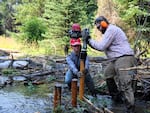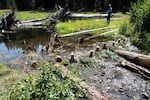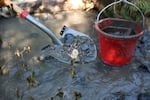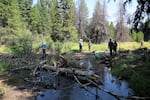
Laura Potter, left, and Kalon Shelden helped drive a fence post in along Sheep Creek at the headwaters of the Grande Ronde River, Aug. 7, 2024.
Kristian Foden-Vencil / OPB
Sheep Creek, a few miles west of La Grande, feeds the headwaters of the Grande Ronde River.
Over the years, the area — nestled in the Wallowa–Whitman National Forest that encompasses northeastern Oregon and western Idaho — has been trapped for beavers, logged for timber and farmed for cattle. A group of a dozen young adults, from 18 to 28, just spent their summer trying to return the creek and its surrounding land to a more natural state.
“We’re making habitat for beavers,” said Luke Hurley, a forestry student at Southern Illinois University.
On one recent Wednesday, the crew pounded a row of six fence posts into the stream then threaded fir boughs in between. On top, they poured river rock and mud to weigh everything down and keep it in place. They were building, in essence, lots of little dams, known as beaver dam analogues.
“Normally, a beaver would do this,” Hurley said. “But hunting and stuff like that has just run them out.”

College student Luke Hurley worked on a crew repairing streams like Sheep Creek this summer.
Kristian Foden-Vencil / OPB
National conservation nonprofit Trout Unlimited hired the young adults to work on its Northeast Oregon Hand Crew. The name reflects the approach — instead of using big mechanical equipment, which can have a large environmental footprint, crews do their work on foot and by hand.
Levi Old, Northeast Oregon project manager with Trout Unlimited, said they are trying to recreate the biodiverse and complex habitat that beavers do naturally.
“They’re a creature that is capable of engineering these whole valley bottoms to be really dynamic places for fish and wildlife habitat,” Old said.
The hope is the beaver dam analogues will slow the river down by spreading it out across the valley, thereby creating a lush and marshy wetland.
Old said the ultimate goal is to attract real beavers, which has happened in similar projects downstream.
“The beavers came back pretty quickly and turned our beaver dam analogues — that might be about 10 feet long — into 80-foot-long valley-spanning beaver dams,” Old said. “And they’ve started to raise families.”

Waters run clear and fresh above a newly finished beaver dam analogue on Sheep Creek in the headwaters of the Grande Ronde River.
Kristian Foden-Vencil / OPB
The work is funded by a mixture of private, state and federal money. For example, the U.S. Forest Service is helping because some of the creek is on its land. The same is true for the Bureau of Land Management. The Oregon Watershed Enhancement Board is spending lottery money on the project. And the Bonneville Power Administration is paying to mitigate for fish killed in its hydroelectric dams.
It’s a complicated and expensive program. But for the young people doing the work, like Luke Hurley, it feels simple and beneficial. He’s loving life outdoors, especially the way he can disconnect from society.
“You know there are societal standards and stuff. But out here, you’re living with the same people for weeks on end. They don’t care. I can just be myself out here,” Hurley said.
Other crew members are using the experience to make new connections, like Laura Potter, an environmental studies student at Boise State University, and Nina Heptig, an animation major at the School of Visual Arts in New York City.

Crews use shovels full of river rock to stabilize new beaver dam analogues along Sheep Creek.
Kristian Foden-Vencil / OPB
“I’d say that out of every other crew that we’ve been around, we like to talk to each other the most,” Heptig said. “We’ve been lucky on that front.”
Heptig and Potter have spent the entire 10-week season together. They both saw elk for the first time and had a close encounter with a bear. One night, their tent was covered in ash from a nearby forest fire.
“I definitely crave purpose when I’m at home, and I think this does fulfill that sense of needing a purpose,” Potter said.
Participants each received a $6,000 stipend for 10 weeks of work plus another $1,800 in educational grants. Heptig and Potter have done the math. It works out to about $15 an hour.
Related: No longer considered predators, Oregon beavers get new protections from state
They’ve loved every minute of it, despite the lack of a mattress to sleep on and a few other challenges.
“I think the biggest struggle is definitely homesickness,” Potter said. “I switch between missing my boyfriend and also having autonomy over my own food. I like cooking at home.”
For Heptig, it’s been the lack of vegetables: “We’re trying to figure out what will keep best over each week.”
The two new friends have vowed to visit each in the future and say the experience has helped them appreciate both the beauty and the harsher realities of living outdoors.
Meanwhile the Grande Ronde Model Watershed Council continues to oversee river improvements with the removal of old culverts and smaller dams. The hope is that in the future, more fish will be able to make the 600-mile migration out to the ocean and back again.

Members of Trout Unlimited Northeast Oregon Hand Crew repairs Sheep Creek, in the hope more migrating salmon will be able to return.
Kristian Foden-Vencil / OPB
